Option 1: Proposal
https://docs.google.com/document/d/1Ht9gFeBcQcLj97QmL7Tc71EhLLxUDKuC4DWSK84Wph4/edit?usp=sharing
Option 1: Proposal
https://docs.google.com/document/d/1Ht9gFeBcQcLj97QmL7Tc71EhLLxUDKuC4DWSK84Wph4/edit?usp=sharing
Bibliography
Ibsen, Henrik. Four Great Plays by Henrik Ibsen. New York: Bantam, 1959. Print.
This book is about a woman that was forced to act as her husbands submissive “Doll”, with constant physical and emotional manipulation. “A Doll’s House” is an important example that shows the gender binary that I could use to develop the claim of how women were seen in society, so I can later explain ways in which artists tried to counter these claims and express their feelings towards society. I think that it is important to have an example of a different kind of source, of a play, to further explain what I was trying to say, and prove that this binary was prevalent in many platforms.
“Women in the 1920s.” Weapons in the War of 1812 | NCpedia, www.ncpedia.org/history/20th-Century/1920s-women.
This article further introduced me to the idea of a post 19th century woman. “A woman of 1920 would be surprised to know that she would be remembered as a “new woman.” It introduces changes that were made including attitude shift towards woman, and attaining voting rights. The artists that I chose to speak about contributed in attaining these changes by displaying the problems with society.
Miller, Jean. “What Were the Traditional Gender Roles of Men & Women in the 1900s?” Our Everyday Life, 27 Sept. 2017, oureverydaylife.com/were-roles-men-women-1900s-8623722.html.
This article was essential in that it gave my argument substance and background on gender roles that were prevalent in the 1900’s, that were previously unknown to me. It is important to have factual background for this kind of argument, so you have a basis and support to explain yourself. Specifically, this article introduced me to the idea that “American women toiled at home to educate children, and had other home chores that limited their interactions with the outside world.”
“1920’s Gender Roles.” Sutori, www.sutori.com/story/1920-s-gender-roles–PRb3DxXk1FC1WWoTPbVgqHHy.
Like “What Were the Traditional Gender Roles of Men & Women in the 1900s?”, this article is important to my essay because it gives background on stereotypical gender roles in society. This source was useful to me because not only did it provide me with background on stereotypes, it brought up the idea that in the 1900’s efforts were made in order to shift gender roles and changing gender stereotypes, which works well with my argument.
“Gender in Nineteenth-Century Art.” Art History Teaching Resources, 23 Dec. 2016, arthistoryteachingresources.org/lessons/gender-in-nineteenth-century-art/.
This article helped me in finding some specific examples of artwork that I could display in showing how women were viewed in society, and what the norms were. It was important to have visual evidence to make it clear for readers of my essay.
“Gender Roles in the 19th Century.” The British Library, The British Library, 13 Feb. 2014, www.bl.uk/romantics-and-victorians/articles/gender-roles-in-the-19th-century.
Not only does this article talk about women in the 1900’s, but it explains the gender binary, that men and women were seen to have certain roles. It addresses both men and women, which is important research to have in my argument to avoid bias, and address both sides. Men were seen as stronger and women were seen as more fragile. This sets up what im going to show, that artists tried to break free of this message and ideology of women.
“Women Artists in Nineteenth-Century France.” The Met’s Heilbrunn Timeline of Art History, www.metmuseum.org/toah/hd/19wa/hd_19wa.htm.
This article from the MET gives insight on the restrictions that women faced in society due due to their ideology of being weak. In this specific article, the MET explains that even if a women craved an education in unlike their male counterparts, women seeking professional careers were restricted in their opportunities, due to their preassigned role.” This is an essential point to my argument to describe that women were at a disadvantage no matter what.
This was my second trip to the MET museum, my first when I was 7 years old, and only in second grade. This time, I was able to soak in a greater amount of the content that the museum had to offer, being that I now have background on pieces and historical eras. In second grade analyzing art was a skill that I had yet to acquire.
The first painting that I encountered was titled Christ Appearing to His Mother”. It is an oil painting created by Juan de Flandes. It’s stability is an eye catching feature that gives away its era of creation, the Renaissance. The painting has a lot of structure to it, and an emphasis on vertical lines, especially in the architecture of the building. Additionally, the background seems extremely distant from the viewer as well. Depth is created, as we can see 3 distinct areas of a room, the front where they are standing, the hallway slightly more behind, and the tiny town in the far background. The lines are very sharp, and straight, depicting little to no motion in the piece.
The second piece of art that I looked at was another oil painting titled “The Annunciation of the Death of the Virgin, by Samuel van Hoogstraten. Unlike in “Christ Appearing to His Mother”, this image was more dramatized, which is a common feature of Baroque art . Here, an Angel is drawn swooping down at a diagonal angle from Heaven. The diagonal line is a distinct difference, as in Renaissance art, more structured is apparent through the use of horizontal and vertical lines. Moreover, the artist used the technique of “smoking,” in which he smoothed out and lessened the sharpness of lines, to give a sense of energy and movement to the piece. These curvatures are generally seen more in Baroque art then in Renaissance art. The clouds were also shaded, adding contrast from the rest of the piece. This feature of shading gave the artwork a sense of realisticness, and less like a drawing. Finally, unlike in the “Christ Appearing to His Mother”, everything seems to be happening in the foreground. Everything seems very close, due to its placement and largeness in scale.
Overall, the features of diagonal lines, shading, smoking, placement and dramatism allow for Baroque art to capture a moving moment in time. In Renaissance art, it seems that the artist is able to capture a still, motionless event, due to the techniques of more structure through having distinct backgrounds and sharp vertical and horizontal lines.

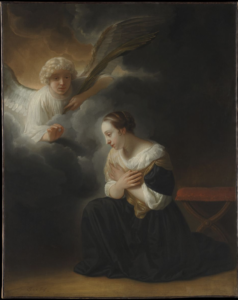
The other night, I was fishing through my cabinet to find the plastic gloves that I use for washing dishes. When I grabbed them out of the cabinet, I accidentally knocked down the box of sponges my mom had left there the night before. As I reached to grab the box off the kitchen floor, I noticed the advertisement placed on the front cover. It depicted a mother standing next to her child, cleaning a window. It read “This mother’s day, get back to the job that really matters”. Ideas that women are supposed to be home, with their kids valuing their “job” that “really matters,” still exist in society. This made me fish through my other items in my house. Astonishingly, the cover of a box of easy bake potatoes that I found in the pantry, read “so easy a husband can do it,” implying that the female is usually responsible for cooking for the family, and the husband is usually incapable of doing so, as it is not his job. This was not coincidental. These simplistic roles of cooking and cleaning devalues a womens capability while placing men on a pedestal of power and knowledge. With powerlessness, society has placed women on a stage permitting extreme amounts of judgement ranging from every stroke of makeup, every outfit and every hairstyle, that is all looked upon with close attention. In a time when the portrayal of a powerful woman was not desired in art, female artists have made groundbreaking attempts to point out these societal problems and bring rise to women’s equality.
The Kneeling women by Camille Claudel
This sculpture places more emphasis on the women and less on the male. Males usually dominate the sculpture- muscular, larger ect (eg. Kouros greek art)… Here the man is not powerful as he is being dragged by the woman to the ground.
The Chess Game (1555)
In this piece, woman are the shown playing chess, a game of logic and critical thinking, that they were seen to lack. However, they are still uncomfortably clothed and dressed extremely consivertively, but artist’s message is a step in the right direction.
Self-Portrait with Thorn Necklace and Hummingbird by Frida Kahlo
Shows the Imperfections of woman also known as “jolie laide.” Breakthrough in not all women being the same, there shouldn’t be an ideal look.
-women is powerful– not afraid to show identity, though society may reject it
-dark shading of eyebrows, mustache
-she is drawn directly centered– center of attention, center of importance
The Father (1920) by Hannah Hoch
Here, Hoch is cutting through male-dominated society, with the medium of a collage. A collage implies cutting through, and pasting onto a sheet of paper in a disorderly manner. It mirrors the situation of anger felt by women who are seen as unequal. Additionally, the artist places male authority heads onto a woman’s body… there is reversal of gendered “roles” here.
DADA-Dance (1919-1921) by Hannah Hoch
Distortions of scale of female body, rejected the “ideal” feminine body.
Das ewig Weibliche by Hannah Hoch
The piece below demonstrates that women in society are thought to be “doll- like”. Their bodies are mangled and cut out and pasted on a piece of paper, which adopts a very chaotic, yet angry tone, drawing a parallel to the feelings of women in society. Several eyes are pasted on the paper, entailing that women are constantly judged in society, based on beauty standards (nails, shoes, hair, makeup) , but also gives the idea of the reversal of the “status quo.” Here the women are looking at the audience, and quite possibly judge the audience for a change. The medium is important as the force of cutting pictures shows anger
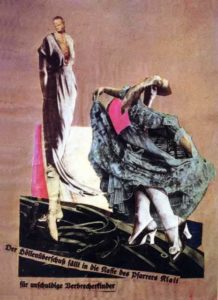




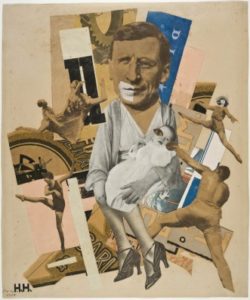
Ancient greece, a city state formed between 800 B.C. and 500 B.C. was ruled by Gods and Goddesses, similar to the ideals of ancient Egypt, however, these supernatural beings were brought down to the standards of the human being. Humanistic actions, emotions, and ideals, were seen through the their artwork. Humanism emphasizes an importance to human culture, our values, problems and needs rather than only the needs and ideals of supernatural entities. The Kouros figure was made to emulate an ideal human, though it was abstract. The eyes, and the face were not as realistic as we see in art from other civilizations. The Kouros stands on its own two feet, which emphasises the humanistic action of walking, and it stands freely. Additionally, other sculptures, such as The Doryphoros, resembling a body-builders highly muscular body type (geometrical and balanced), resemble humanistic qualities, because they reflect Greek values. For example, the sculpture may have emulated this male physique because of their participation in the military, and their love of sports as well. The artist chose to show that they are physically fit, and “God like”, yet have human values. Additionally, nudity was a major factor in Greek humanism. They embraced nudity, which was a sign of Greek culture, allowing the focus to be on the individual rather than their status in society, unlike in Egyptian art.
Ancient Egypt, founded in the Early Dynastic Period (3100-2686 B.C.) highly valued their gods and goddesses. Unlike in Greek art, in Egyptian art, the Gods and Goddesses were seen as completely separate beings, that were not supposed to have human like attributes. They were held at a separate rank in society. Unlike in Greek civilization, where artwork showed gods and goddesses that were standing freely, in Egyptian art, Gods and Goddesses were boxed in the walls of pyramids, creating a sense of separation and distance between humans and gods. They were also clothed indicating their hierarchy, as nude figures were looked down upon in society.
Finally in ancient Rome, founded in the 8th century BC, hellenistic art, which was inspired by Greek art was created. We see a shift to a more realistic form of the human being. Realism, an unidealized form of the human being was seen in their artwork. In Roman Portraiture, emphasis was placed on age, by showing details in the skin including wrinkles. They emphasized age to show the importance of wizdom, learning, experience, achievement (possibly in the military), and patience in society. Romans showed things how they actually look in the natural world, not placing ideals on looking “perfect”. Adding on, In Roman art, figures were clothed, unlike in Greek art. Finally, we see an appearance of a female figure, who were seen as non human in ancient Greece.
Within ancient cultures such as Greece, Egypt and Rome, their specific values and traditions are reflected in each of their different styles of art. Unlike in ancient Egypt, where Gods and Goddesses were held at the highest value in society, in Greece, an emphasis on the ideal human was reflected in their art and in Rome, a more realistic human was depicted.

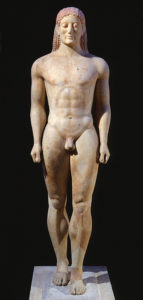
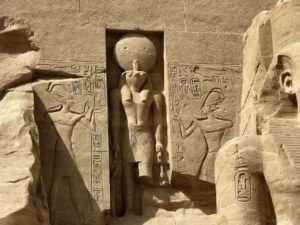
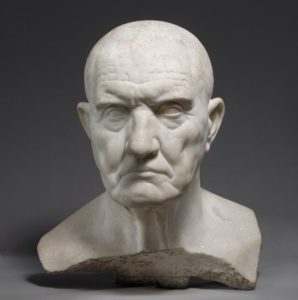
Humanism emphasizes an importance to human culture, our values, problems and needs rather than supernatural entities. This was a philosophical breakthrough, because humans were the now center of attention, rather than God and Goddesses. These supernatural beings were actually brought down to human actions, emotions and ideals, which is seen through the variety of Greek artwork. Gods were able to have human like attributes. Additionally, Humanism focuses around the idea of thinking critically in terms of empiricism, the idea that human knowledge and thought derive from sensory experience. The environment and interactions with sensory stimuli dictates what you think.
The Kouros figure was made to emulate a human. It stands on its own two feet, a human attainable action. Even the other sculptures resembling body-builder highly muscular body types, resemble humanistic qualities. The sculpture may have emulated this male physique because of their participation in the military, and their love of sports as well. The artist chose to show that they are physically fit, and “God like”, yet have human values and passions. Additionally, nudity was a major factor in Greek humanism. They embraced nudity, which was a sign of Greek culture, showing that they are all equal, and allowing the focus to be on the individual rather than their status in society, unlike in Egyptian art. In Egyptian art, the figures were boxed in creating a sense of separation and distance between humans and gods. Additionally, they were clothed indicating their hierarchy, as nude figures were looked down upon in society.



Michael DeGennaro
When entering the Brooklyn Museum’s soul of a nation exhibit, I was strikingly hit with emotion rooted in the history in the artwork surrounding me. This exhibit celebrates the work of Black American artists from 1963 to 1983. During this period the dreams of the Civil Rights Movement were formed and black artists across America worked to create a range of art in response to the moment. The Flag is Bleeding, 1967 by Faith Ringgold particularly spoke to me. This painting is a questioning of the reality of what the American flag symbolizes. It is interesting because a flag is intended to represent unity of a nation, yet here, it is blood shed and as a symbol for racial inequality and violence. A black man is putting his hand over his heart, which is an American symbolization of unity when reciting the national anthem, yet his heart is wounded, yet he is holding a knife, preparing defense for future attacks. The white male figure‘s dominating stance demonstrates his power in society, implying racial status and hierarchy. He is unwounded and standing with his arms to his hips, dressed in a suit which connotes as highly authoritative. The female in the middle attaches both males at either ends and interlocks them, showing they are all connected under this unjust system, yet they are all unequal. The artists choice to have a flag oozing deep red blood, in a manner that is very blotchy and scattered depicts the reality of this long drawn battle.

Michael DeGennaro
Choose one artwork from the ancient world (your choice, but the BK Museum has a good selection of Mesopotamian and Egyptian art), use formal analysis to talk about the work and relate it to some of the concepts we have discussed in class.
This cartonnage/mummy was particularly eye catching to me because when I think of ancient Egypt, the mummification process instantly pops into my mind. As as a child, it is what mostly interested me when learning about the ancient civilization. Mummification and the preserving of the human body is an art form in itself, adding makeup, and trying to rejuvenate diminishing features is difficult. Though this piece of art is titled “Mummy of an Anonymous Man”, features that the artist chose to include can indicate his level of importance. On the exterior, the artist depicted a human head, whose eyes are wide open, glaring at his viewer. This shows that although their physical body has died, they are still alive and watching closely and intently from the afterlife. His skin is a dark red-brown skin color which in ancient egypt, represented outdoor life and pursuits of men. Red was also the color of precious stones which can indicate his value. The artist chose to groom the man very sharply and neatly, similarly to the neatly groomed, though much longer beards we looked at in class, which can indicate his status in society as well. The faded burgundy patch on his shoulder is an ancient symbol for holiness, which the artist chose to include as a sign of his possible God-like value. The gold necklace, as well as the sold idea of being preserved alone indicated that you are apart of the upper class, and your legacy will live on in the after life.

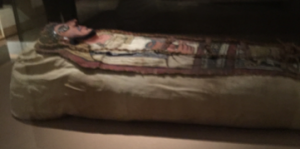
Michael DeGennaro Unit 1 Summary
In this unit, we really were able to explore with the idea that art is a vehicle for expression that comes in limitless forms such as music, dance, doodling, drawing, painting and much more. It has a different connection with everyone.
Something that especially resonated with me was learning about Freire’s banking model of education. It is a concept in which the teacher is the active being and the students are passive “objects” in the classroom. The students are essentially sitting down and listening to a teacher making “deposits” of education into their head, which they memorize information, and repeat this process daily. Frier explains that this type of education allows for no intellectual growth in students, as they are simply intaking information that means nothing to them. It was interesting to conceptualize this experience, as in sophomore year of high school, my geometry teacher perfectly emblemized this model. We as the students sat down for an entire hour, No speaking, no questions, no interactions, listened to him talk about factoring polynomials , pack up, leave, and repeat this for an entire school year. We were overwhelmingly being fed geometric concepts. We didn’t make connections with the material being “collected.”
“Art is one’s own world of creativity”. From this basis, we were able to dive into the meaning of formal analysis, questioning and seeking answers to these visual and physical elements of a piece of artwork and determining the message that the artist is trying to convey. We were able to explore the different elements to look for in a formal analysis. Line including emphasis and contour, color including identifying different hues, space/mass including dimension, form (weight and volume), and scale in terms of relative size of objects are all elements that we as the viewers take into consideration. We got to explore these concepts by looking at ancient artwork in class, ranging from Mesopotamia to Egypt.
Shortly after learning about formal analysis, my family and I took a trip to the Brooklyn Museum, and I was able to practice my own formal analysis on Johnson, A Ride for Liberty — The Fugitive Slaves. The painting depicts a family of slaves on a horse, crossing battlefields from the Confederate South to the Union North in order to escape the treacherous conditions of life. The main focus of the painting is the horse, as it is placed in the middle of the work, and it is the largest piece in the work. The artist placed emphasis on it with his use of contrasting colors: dark colors in the horse against a light background. The artists light brush strokes on the horses tale, and its placement slightly above the ground, with legs in a galloping motion, indicates that it is running. The sheets on the horse are very silky and airy and the horse is very majestic and beautiful. This concept to me was interesting because it symbolizes something beautiful bringing peace and aid to a treacherous situation.
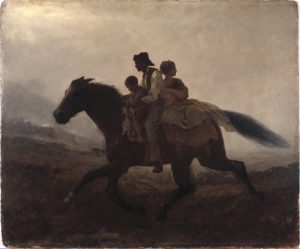
Michael DeGennaro- Post#4 / Art 1010
What is formal analysis? In your own words explain what we mean when we say formal analysis and what its components are
When looking at a piece of artwork, we notice several physical elements of the work. Take “The Starry Night” by Vincent van Gogh for example. Our eye draws us to noice the texture of swirls in the wind, the contrasts of color including the different shades of blue in the sky, a bright, radiating yellow sun, and a dark green/black mountain range. We notice the physical definition of fore, middle and backgrounds, and begin to think about why van Gogh emphasized the Alpilles mountains, and much more. Was Van Gough depicting a windy, fall night? Formal Analysis is defined as questioning and seeking answers to these visual and physical elements of a piece of artwork and determining the message that the artist is trying to convey. Line including emphasis and contour, color including identifying different hues, space/mass including dimension, form (weight and volume), and scale in terms of relative size of objects are all elements that we as the viewers take into consideration. Together, these elements make up a composition, the piece of artwork itself. When analyzing these elements, we as the viewers determine the artists intended visual effect. For example, why things are emphasized using colors and other features, the emotion that the piece portrays, and the perception of the piece. We as the viewers begin to contextualize and interpret the answers to these questions based on our personal experiences and education. For example, I could think that van Gogh is painting a fall night, because of what I imagine a fall night being, certain shades of blue, and the weather itself, but my sister could think it is a summer night, based on her perception. In formal analysis, we determine what the artist is trying to accomplish through his or her visual.